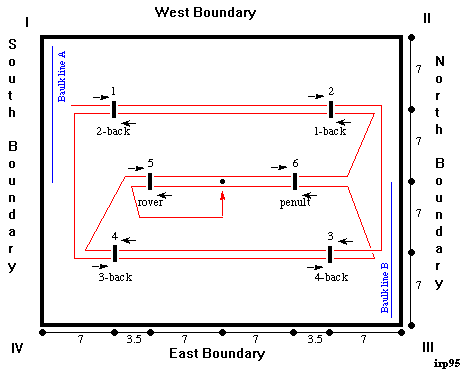Rules of croquet
THE SIMPLIFIED LAWS OF ASSOCIATION CROQUET
Below are the simplified rules of the game of croquet to be used in this competition. Some rules have been removed in order to simplify the game.
The Basic Game
The game is a race around the circuit of hoops shown in the diagram below. The Blue and Black balls play against the Red and Yellow balls. The first side to get both of their balls through the 6 hoops in order and hit the peg is the winner. Once a ball has completed the circuit and hit the peg (pegged out) it is removed from the game. In this tournament, each ball is required to go through all six hoops ONCE before pegging out. Due to the size restriction of our croquet lawn, the yard-line will lie on the 1/2 yard from the boundary In each turn the player may strike only one of their balls (the striker’s ball) with the end-faces of the mallet. By hitting the striker’s ball the player may cause any other ball to move and to possibly score its hoop point. When the striker’s ball has been through the last hoop it is known as a rover, it may then cause another rover to score a peg point by making it hit the peg and be removed from the game. The players play alternate turns. A player can start their turn by striking either of their balls but must thereafter strike only that ball during that turn. A turn consists of a single stroke, after which the turn ends, unless in that stroke a). the striker’s ball scores its next hoop in which case it earns a continuation stroke, or b). hits another ball when it gains a croquet and continuation stroke. The striker’s ball scores a hoop point for itself by entering a hoop from the correct direction and passing sufficiently through the hoop so that no part of the ball protrudes from the side of the hoop it entered by (runs a hoop). This may occur in one or more turns. On running the hoop the striker gets an extra stroke – a continuation stroke. If the striker’s ball causes another ball to run that balls hoop, that other ball is said to be peeled through the hoop and it gains a point. You do not gain a continuation stroke for peeling a ball. The score is the sum of the number of hoops and peg points each side has obtained. If the striker’s ball hits another ball (makes a roquet) the striker gets two extra strokes. The first extra stroke is the croquet stroke and is played by picking up the striker’s ball and placing it in contact with the roqueted ball. The striker “takes croquet” from the roqueted ball which then becomes the croqueted ball. Following the croquet stroke the striker has a continuation stroke on their own ball. At the start of each turn the striker’s ball may roquet each of the other three balls once. However, every time the striker’s ball scores its next hoop point it may roquet each of the other three balls again. The striker can roquet balls, run its next hoop and roquet the balls again, etc., so making a break. A ball can roquet another ball directly or after being scattered off a hoop, peg or other ball which it has already roqueted. If at the start of a turn the striker’s ball is in contact with another ball and the player chooses to play with that ball, a roquet is taken to have been made and you must take croquet immediately. If a player completely runs their hoop and roquets a ball lying completely outside the jaws of the hoop then this is taken to be hoop run then roquet. Croquet must then be taken. A ball which has made a roquet is still in the game and can cause other balls to be moved and potentially peeled. Once it has made a roquet the striker’s ball may not score hoop points for itself in the same stroke. In the croquet stroke the croqueted ball must move or shake. If it does not the balls are replaced and the turn ends. The turn also ends in a croquet stroke if the croqueted ball is sent off the court, unless it is pegged out in that stroke, or if the striker’s ball is sent off the court without making a roquet or running its next hoop. The continuation stroke is an ordinary stroke in which, for example, a further roquet may be made or a point may be scored. Continuation strokes cannot be accumulated; for example if you run your hoop and make a roquet in the same stoke you must take croquet immediately. The game starts with the toss of a coin. The winner of the toss decides whether they will take the choice of lead, i.e. which side plays first or second, or which pair of balls (Blue & Black or Red & Yellow) they will play with. If they take the choice of lead the adversary has the choice of balls and vice versa. At the start of a game, the player entitled to play first plays either of their balls into the game from any point on either baulk-line (see diagram). At the end of that turn their adversary does likewise. In the third and fourth turns the remaining two balls are similarly played into the game. As soon as a ball is played on to the court it can immediately score points and make roquets. Once all four balls have been played on to the court the striker can start any subsequent turn with either of their balls. At the end of each stroke any ball in the yard-line area other than the striker’s ball, which is played from where it lies, is brought back onto the yard-line nearest to its position. If at the end of a turn the striker’s ball lies within the yard-line it is brought back onto the yard-line. Any ball which has left the lawn is brought back onto the yard-line unless it is the striker’s ball due to take croquet. A ball goes off the court as soon as any part of it crosses a straight edge raised vertically from the inside of the boundary. If a ball cannot be exactly replaced on the yard-line because of the presence of other yard-line balls, it is replaced on the yard-line in contact with those balls. (a) A ball is wired from another ball if: (i) a hoop or the peg would impede the direct course of the striker’s ball towards any part of the other ball; or (b) If, at the beginning of a turn, the striker elects to play a ball: (i) for whose position the opponent is responsible; and
1. The Object of the Game

2. The turn
3. Scoring Points
4. The Roquet
5. The Croquet
6. The Continuation Stroke
7. The Start of a Game
8. Balls off court and in the yard line area
9. Wiring Lifts
(ii) the swing of the mallet prior to impact with the ball is impeded by a hoop or the peg; or
(iii) any part of the striker’s ball is within the jaws of a hoop.
(ii) which is wired from all other balls; and
(iii) which is not in contact with any other ball then he may lift that ball and play it from any position on baulk-line A or B, or play it from where it lies.
